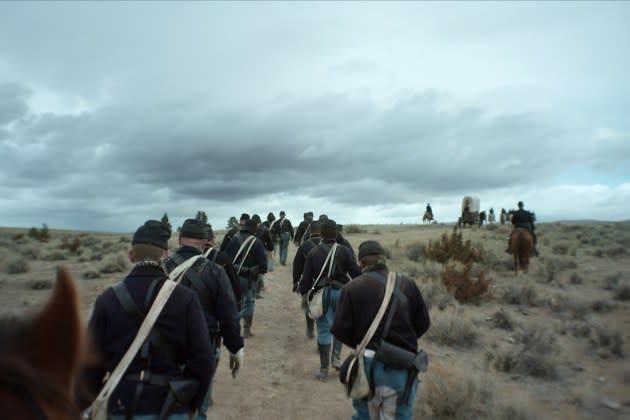‘The Damned’ Review: An Immersive Civil War Drama That Whisks Us Into America’s Troubled Past

Italian filmmaker Roberto Minervini’s artfully crafted movies, which include such works as Stop the Pounding Heart, The Other Side and What You Gonna Do When the World’s on Fire?, have always sat in a murky gray zone separating fiction from documentary.
Nonprofessional actors play themselves, or versions of themselves, in narratives that seem to have been crafted out of their own lives. And while the locations are always real places, with an emphasis on swaths of the American South — as his name suggests, Minervini is Italian, but he’s lived in the U.S. since 2000 — the director transforms them into sublime backdrops for his gritty tales of poverty and abandon.
More from The Hollywood Reporter
Legends of "New Hollywood" Return to Cannes After Decades Away
'Anatomy of a Fall' Breakout Messi the Dog Laps Up Attention at Cannes
China Box Office: 'Furiosa: A Mad Max Saga' Cleared for Release (Exclusive)
His latest film, The Damned, is not technically a documentary: It’s set in 1862 at the height of the Civil War and follows a pack of Union soldiers treacherously exploring unmapped territories in the West. And yet, if it were possible to send a camera crew back into the past to capture such an event, the result would be something close to what Minervini delivers in this quietly intoxicating and existentially real war movie.
“Real” in the sense that there’s not much action except for one long and deadly battle sequence, while the rest of the film mostly entails soldiers sitting around and killing time, which is what often happens in war. And real in that the cast consists of average men who look the part, especially dressed in those dark blue Union uniforms, but talk more or less like men talk today. So again, we’re floating somewhere between reality and fiction, as if The Damned were a time capsule of the past that’s been washed in the light of the present.
That light is certainly alluring, with cinematographer Carlos Alfonso Corral (who also composed the music) filming the troops in exquisite shallow-focus compositions where the breathtaking Montana backdrops are slightly blurred. The aesthetic brings to mind Terence Malick’s The New World and Alejandro Iñarritu’s The Revenant — both were shot by the great DP Emmanuel Lubezki — which combined historical realism with an enhanced naturalistic style, finding untold beauty in America’s troubled and violent past.
In some ways, The Damned plays like a low-key, laconic version of those films, where weary men converse with one another about God, or more mundane things, as they wait for death to creep up out of nowhere and take them away. This happens about a half hour into the action, when the soldiers suddenly get ambushed in their encampment, resulting in a lengthy and mesmerizing rifle battle set during twilight. It may be one of the prettiest battle sequences in recent memory.
Who, exactly, is attacking the Union Army is never made clear, and Minervini seems less concerned with historical details than with capturing a certain state of loss and confusion among the troops. “We’re killing other people, other Americans,” one trooper complains to the others, reminding us — in the same vein as Alex Garland’s Civil War, though much less bluntly — that we’re currently living in a divided country.
Although there are no main characters for most of the story, the film eventually focuses on four soldiers who split off from the rest of the squad to scout a route through the mountains. Instead of perishing together in one final battle, they gradually drift away into the fog of a war they never manage to fully grasp, hoping that they’re doing more good than evil, and that the Lord will deign to save them.
But as the title states, these soldiers may be damned from the get-go. When we cut back to the original camp at some point, there are only dead bodies left on the ground, in images reminiscent of Matthew Brady’s stunning photographs of Civil War battlefields. Minervini leaves us feeling that, although the Union did of course win the war, their victory would lead America back to where it is now, on the brink of another major schism. As Faulkner famously wrote: “The past is never dead. It’s not even past.”
Best of The Hollywood Reporter

 Yahoo News
Yahoo News 